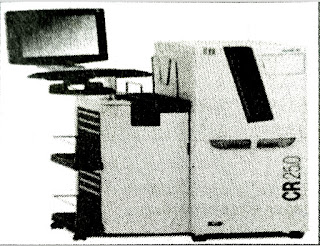 |
| Digital Radiography (DR system) |
In this article, you able to know;
- Digital Radiography
- Advantages of the DR system (Hospitals, Radiologists)
- Benefits of the DR system
- Computer Radiography
- Benefits of the CR system
What Is Digital Radiography?
Digital Radiography is a form of X-ray imaging, where digital X-ray sensors are used instead of traditional photographic film. It makes use of a digital image capture device, hence called Digital Imaging (DR) or Computed Radiography (CR) system.
CR systems use storage phosphor image plates with a separate image readout process. DR is a way of converting X-Rays into electrical charges by means of a direct readout process
 |
| (DR system) |
As we can see in the Article, the image on the upper represents a DR system while that on the lower represents a CR system.
In Conventional Radiography, with X-ray film development in a dark room the efficiency is limited, thus the requirement of exposure parameters is more.
In Digital Radiography performed with "Computed Radiography "Or Digital Imaging Radiography (CR and DR systems) the efficiency of conversion of X-ray photons to an electronic image obtained is much better resulting in very good image quality at relatively lower exposure of radiation on the patient.
What are the Advantages of Digital Imaging?
The advantages of digital imaging are as follows:
- Promises very rapid access to images and provide better image quality than conventional film-screen technique
- Images are better than those with film-screen technology with high spatial and contrast resolution & dose efficiency.
- The weight is very much lower than the conventional film cassette, thus it is easier to handle.
- Interface well with Hospital Information System (HIS) and conveniently output images to printers, archives, and workstations.
- Minimal changes from existing cassette systems, 14"*17"scanning area, solid-state robust design.
- Imidiatede access with HIS (Hospital Information System), PACKS (Picture Archiving and Communication System), and DICOM (Digital Communication) connectivity.
Advantages of the DR system for Hospital;
- Negligible repeat examinations increased room use and reduce cost
- Higher productivity
- Improved patient care
- Eliminates the need for conventional film processing
- Reduces load on the purchasing department for the frequent ordering of darkroom chemicals
Advantages of the DR system for Radiologists;
- Rapid, good quality images, easy transmission, display, and archive & retrieve.
- Capture and convert X-Ray images into digital format within seconds of exposure enabling technicians to preview each image prior to completion of the examination procedure.
- Enhance workflow through the distribution of images. The digital image can be transmitted electronically via reading on monitor or printing or storage
- Easy adjustment of an electronic image at the work station.
- Images can be communicated to other location for a second opinion
- Data on the workstation does not get affected due to multiple viewing of storage modalities.
What are the Benefits of the DR system;
- The Benefits of the DR system are as follows:
- Enhanced throughput
- Radiographs are made available immediately
- Images can be transferred whenever required through electronic media
- Very good image quality due to High Signal to Noise Ratio (S/N)
- Overtakes are almost nil
What Is Computer Radiography?
 |
| (CR System) |
In computer Radiography, the steps taken during the procedure while exposing patient are as follow:
- Patient position technique remains the same for all modalities
- The image plate is charged and mechanically reinserted into cassette ready for Exposure/reuse
- The imaging plate is exposed to X-rays
- The image plate from the cassette tray is taken to the CR reader after exposure
- The image plate is scanned by a laser beam of a CR reader (~700nm) swept across the image plate by a rotating polygonal mirror
- The light emitted from the image plate is collected by a fiber-optic bundle and funneled into a photomultiplier tube (PMT)
- PMT converts the visible light into e-current
- Electronic signal out from PMT to an ADC
- Digital output from ADC stored
- X-Ray> light> PMT> Electrons> ADC> RAM
- The image is displayed on the monitor
- A hard copy of the same can be printed through the laser camera. Computer hard disc stores image
- Image Plate exposed to bright light to erase any remaining trapped e- (~50%)
- Image Plate mechanically reinserted into cassette tray, ready for reuse
- The overall process takes 6 to 7 minutes
Benefits of computer radiography:
The benefits of computer Radiography are as follows:
- Many exam rooms serviced by one reader
- Lower initial cost
- The final image can be stored in digital form
- No darkroom procedure required to process the film
- No darkroom & chemicals required for processing the film

Post a Comment